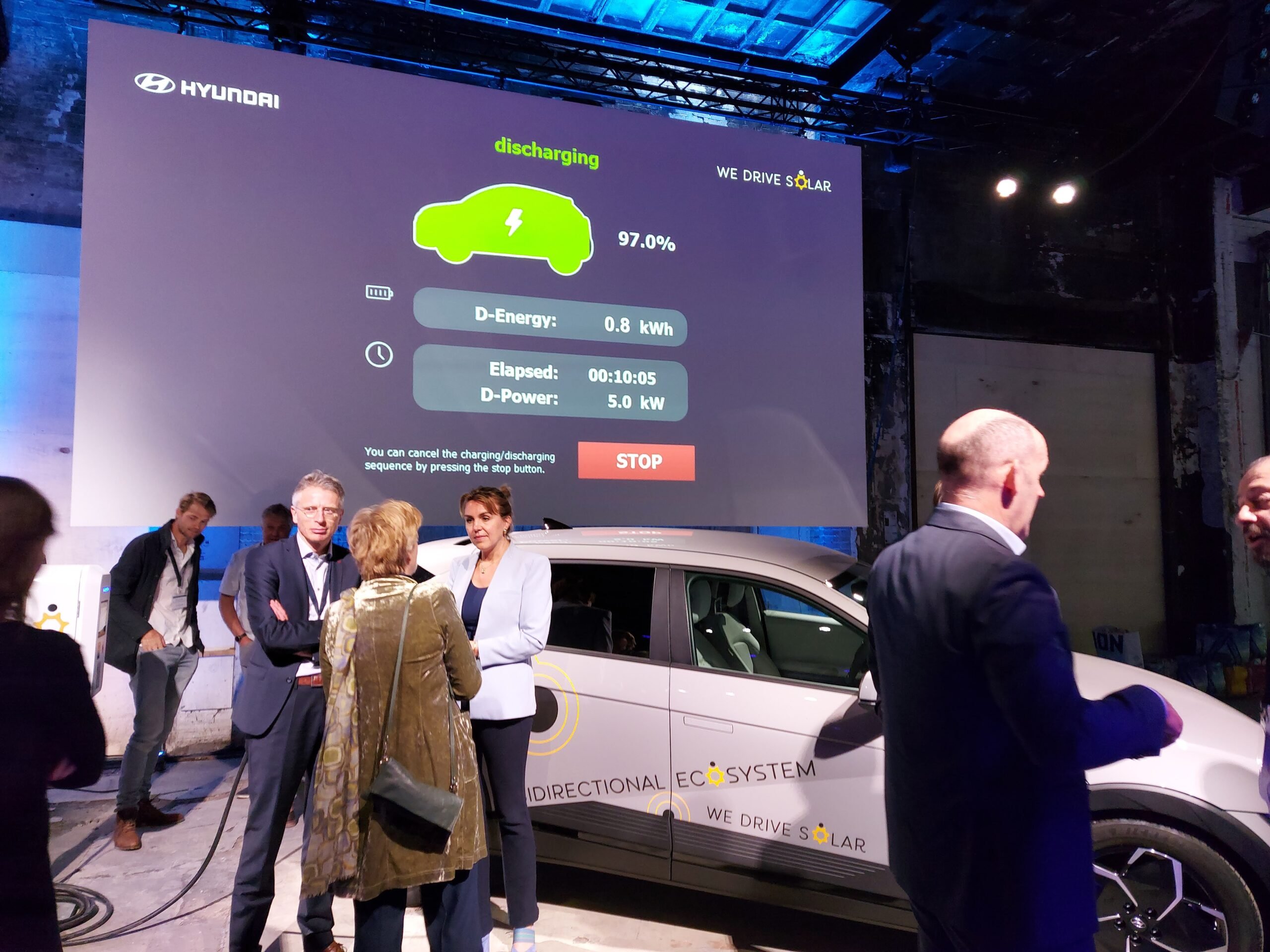
Light effects, lasers and music. All electricity needed for these today will one day be provided by an electric car. And later, there will even be enough to power the yet-to-be-built Utrecht district of Cartesius. This will make it the first so-called bi-directional neighborhood in the Netherlands. But before that happens, the car sharing platform We Drive Solar is rolling out a system together with Hyundai across Utrecht whereby cars are also able to feed electricity back into the grid: Vehicle to grid or V2G. They are currently operating with 25 cars (the Hyundai IONIQ 5) and plan to expand to 150 cars later this year.
IIn the CAB building, where the NS public transport service used to repair their buses, the first car was put into service today. It is a world first for Utrecht, says Hyundai Europe CEO Michael Cole, the city will be the first region in the world to have the opportunity to adopt this technology on a large scale. “In doing this, you combine different types of mobility, such as sharing platforms, with innovative energy systems. Not just cars to drive in, but you’re also supplying energy to households.”
The region is more than happy to seize this opportunity. What’s more, according to Robin Berg, director of We Drive Solar, the city is also ahead of the curve. “There are already around 700 chargers in the city that are compatible with this technology. It’s just a matter of waiting for car manufacturers to come up with V2G models like Hyundai.”
Congested electricity grid stands in the way of transition
Under the Paris Climate Agreement, we should be generating all of our electricity from green sources by 2050. In 2021, 33 percent of the total electricity generation in the Netherlands came from renewable sources. But as we generate more and more green energy, the electricity grid is becoming congested in more and more places. In order to prevent overloading, grid operators sometimes switch off solar panels in neighborhoods during peak hours. Car batteries offer a solution in such cases. Berg: “We only use about a quarter of a battery for commuting to and from work. If you charge the battery during peak hours – when the sun is shining brightly – you lighten the load on the grid and you have enough capacity left over to use at times when the sun is not shining.”
According to Matthijs Kok, developer of electric transport and new forms of energy for the municipality of Utrecht, the demand for energy is set to grow enormously in the near future. Not only are houses being disconnected from gas and have to be heated electrically, but the growth of electric cars is also playing a role in this trend. “In 2030, we expect to have about 55 thousand EVs in the city. That’s 44 percent of all cars. At present, we don’t have the right infrastructure to handle this growing demand for energy. In addition to costing a lot of time and money to reinforce the grid, we also need 14 acres – 21 soccer fields – of land, including transformer substations, to convert the energy. That’s just not possible in a densely populated city like Utrecht,” says Kok.
Bi-directional charging offers solution
But, he points out with a sense of enthusiasm, grid reinforcement is not the only solution. For example, there are other ways to relieve the grid. Neighborhood batteries and energy storage in the form of V2G. “These 25 electric cars are a start. However, it does mean that we don’t need to install additional transformer substations in certain places. According to grid operators, you can supply about nine to ten households with electricity from a charged electric car. Research by Utrecht University shows that we need about 8,000 cars to power the entire city during a cold night.” The next challenge lies in the energy market, which he says needs to be a lot more flexible. “This involves sitting around the negotiating table with all the various stakeholders, from energy suppliers to grid operators.”
According to the director of We Drive Solar, Berg, users of the sharing platform don’t have to worry about suddenly being left with a dead battery because households are drawing too much energy. “We have an awful lot of information. This lets us know exactly when cars can be used to relieve the grid and when they are needed for trips. We need to put our efforts into more flexibility within the energy market. We cannot do this alone, and this is why we are working together with various partners such as grid operators, ElaadNL and others.”
New neighborhood with a focus on green mobility
Cartesius, a triangle between two train tracks on the former NS shunting yard, is to house over 2,800 homes, two parks and a variety of amenities. According to developers MRP and Ballast Nedam Development, residents will live ‘longer, healthier and happier’ in the new neighborhood. The first residents will be able to move in around 2023. The plan is inspired by blue zones, areas of the world where life expectancy is highest. “The well-being of people is at the heart of it,” states Onno Dwars, CEO Ballast Nedam.
Energy will be generated by solar panels on the roofs in the neighborhood and a surplus of solar energy can be stored in We Drive Solar’s shared cars. Residents can use this stored energy at a later time. For instance when the sun is not shining. According to Utrecht Mayor Sharon Dijksma, this is how we will solve peaks in our green energy supply in the future. “We are facing a huge challenge and this is the revolution that we need to enable the energy transition. Utrecht wants to stimulate green innovation. With this bi-directional grid, we want to show the rest of the world that it can be done.”

